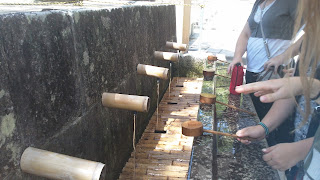I wrote in my initial post that my biggest impression of Japan was how different it initially appeared. I then ended with the statement that I was starting to see more similarities; I could see myself settling into a routine in Japan.
And that is exactly what happened. Sometimes, I stop biking, look up to the sky, and think, “Wow. I’m in Japan. I’m on an island, in the Pacific, miles from home, in the country I have aimed to visit since my High School days.” It boggles my mind and it’s sometimes hard to believe.
In the beginning, I would look at the differences and exclaim, “Wow! Look at the differences! The culture and history is so different, exciting, and alive!” But now, I look at the temples, I look at the old style buildings, the tourist areas, and it sometimes seems forced. In certain areas, the old-style buildings and small temples flow into the cityscape. Certain events, like the koto concert I attended, feel natural. In a way, I’ve become so accustomed to things that aren’t ‘American’ that it feels natural. So when I see those temples blocked off for display, such as the golden temple at Hiraizumi, or the relics in a museum, it feels detached. It doesn’t feel like ‘Japan.’ It feels like those photos I can pick up at home.
And that is where I feel my impression has changed the most. In America, my view of Japan was those old-style buildings, the temples, the tourist attractions, the sites that were unique and a blast from the past. Now… Now, Japan to me is where the past streams seamlessly into the present so it becomes indistinguishable. I bike down the street in the morning, company employees sweeping leaves off the sidewalk, old wooden buildings with a shrine nestled in between as cars fly by it, students running by with yellow hats or matching backpacks… And I don’t bat an eyelash. It’s natural; it isn’t given a second look. I go to the World Heritage sites and it’s so detached because of seeing so many pictures in America; it strikes me as feeling more like home or ‘international.’









